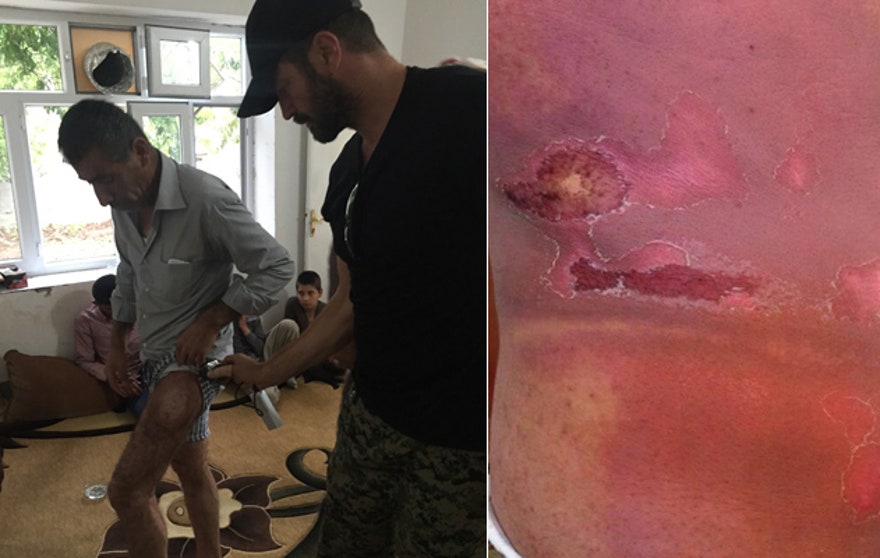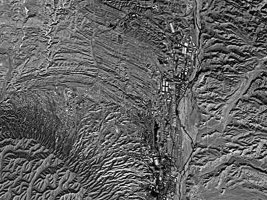It must be said and remembered that Barack Obama and John Kerry demanded action on Syria due to the red-line being crossed. No one had the will, so chemical weapons have been used often and in Iraq as well.
When it was said by the American people, that Syria was not our war and we had no international obligation or interest, think again. Barack Obama today approved 10,000 Syrian refugees into our homeland, with the option of up to 30,000. Now, it is our problem.
US official: ‘IS making and using chemical weapons in Iraq and Syria’
BBC: There is a growing belief within the US government that the Islamic State militant group is making and using crude chemical weapons in Iraq and Syria, a US official has told the BBC.
The US has identified at least four occasions on both sides of the Iraq-Syria border where IS has used mustard agents, the official said.
The official said the chemical was being used in powder form.
The US believes the group has a cell dedicated to building these weapons.
“They’re using mustard,” the individual said of IS. “We know they are.”
The mustard agent was probably being used in powder form and packed into traditional explosives like mortar rounds, the official said.
When these weapons explode the mustard-laced dust blisters those who are exposed to it.
Alternative theories
The official said the intelligence community believes there are three possible explanations for how IS acquired the deadly chemical agent.
The most plausible in the eyes of intelligence community, according to the official, is that they are manufacturing it.
“We assess that they have an active chemical weapons little research cell that they’re working on to try and get better at it,” the official said.
The alternative theories are that IS militants found chemical weapons caches in Iraq or in Syria.
It is unlikely that militants found the chemical agent in Iraq, the official said, because the US military would have likely discovered it during the military campaign it waged in the country for about a decade.
The official said that militants were unlikely to have seized the chemical agent from the Syrian regime before the regime was forced to hand over its stockpile under the threat of US air strikes in 2013.
The most likely theory, the official said, was that it was being made using knowledge that is widely available, and pointed out that the mustard agent is not a complex chemical to produce.
The US government’s position continues to be that it is investigating claims of chemical weapons use in Iraq and Syria, but the official speaking to the BBC said that many intelligence agencies now believe there is now enough evidence to back up these claims.
The official requested anonymity because that person was not authorised to speak about it publicly.
***
Exclusive photos appear to show grisly effect of ISIS’ mustard gas attacks on Kurds
FNC: Kurdish forces battling ISIS in Iraq are suffering severe health effects and pleading with the international community for help after being attacked with chemical weapons including mustard gas, according to a western military expert embedded with them who provided gruesome photos backing the charges.
Exclusive images obtained by FoxNews.com show Kurdish fighters afflicted with the telltale burns and blisters sustained after fierce fighting as recently as last week in the mountainous Barzani Province. Fighters described being targeted by mortars that exploded to unleash clouds of toxic chemicals. Several are now being treated as recently as last week for severe burns and blisters, debilitating breathing problems and even blindness.
“The Kurdish forces have been attacked multiple times with chemical weapons – the last time was a week ago,” said Tony Schiena, of MOSAIC, a private military and intelligence outfit based in the U.S. and London that trains foreign militaries in tactical operations and intelligence gathering. “They are horrified, not only by the Islamic State’s use of mustard gas, but also chlorine, as well as another unidentified chemical agent they were told by foreign advisors could be sarin.”
“ … the way these symptoms changed over time, and the patients’ testimony about the circumstances of the poisoning all point to exposure to a chemical agent.”
– Pablo Marco, Doctors Without Borders
Sarin, a designated weapon of mass destruction, is a colorless and odorless nerve agent, while mustard gas is a chemical warfare agent widely used by the Germans in World War I.
Schiena, a former South African special operator hired to train Kurdish Peshmerga Special Forces in Iraq in counter terrorism and defensive tactics, told FoxNews.com he traveled with the head of Peshmerga military intelligence over the last several days through the mountains of the Barzani Province to the front lines. There, he met with base commanding generals, medics and victims of chemical weapons attacks who, in some cases, are still struggling a month after exposure.
Schiena said the fighters described a yellow gas that smelled like rotten onions and garlic, descriptions consistent with mustard gas. He said the Kurds desperately need masks and protective suits to continue their fight against the black-clad jihadist army. ISIS is armed with sophisticated weapons seized from Iraqi forces, plundered stockpiles from the arsenals of Saddam Hussein and an increasing number of improvised weapons, including chemicals, Schiena said.
For example, the Islamic State uses propane canisters filled with bolts and nails, valves added to either side, with a tail and wings welded on, to create a rocket that explodes on impact. The rocket disperses flaming hot bolts and nails as well as chemical weapons and can set off vehicle-borne improvised explosive devices such as a Hummer laden with explosives, or ordnances attached to suicide bombers.
One Kurdish soldier said that of 52 mortars ISIS launched at his team during one attack, three released yellow smoke that caused their skin to immediately water, discharge liquids, blister and create large wounds. Soldiers exposed to the gas vomited and experienced extreme abdominal pain and severe burning and itching eyes. Other mortars discharged a silver glittery substance that stuck to their skin like glue. The Kurdish soldiers said the Iraqi military also said ISIS used these chemical weapons on their forces.
“Imagine being the only organized force fighting this great evil on the front lines, getting hit by chemical weapons and you have nothing, not even a mask to protect yourself,” Schiena said.
Schiena appealed to Prince Ali of Jordan, who he said arranged for delivery of 1,000 gas masks, but said many more are needed. He questioned why the U.S. and other countries aren’t providing more support to the Kurdish fighters.
Ryan Mauro, national security analyst for the Clarion Project, said one key question is where the chemical weapons originated from.
“Are they from the old stockpiles that Saddam Hussein supposedly didn’t have, or did they come from the Syrian regime’s stockpile that they claim to have disarmed?” Mauro asked.
Germany’s Federal Intelligence Service BND has documented the Islamic State’s use of mustard gas, according to a Sept. 7 article in the German daily newspaper Bild, which said agents took blood samples from Kurds injured in clashes with ISIS in Northern Iraq.
While the U.S. Defense Department won’t confirm the Islamic State is using mustard gas, Pentagon spokeswoman Cmdr. Elissa Smith said officials have reviewed the most recent reports detailing the alleged use of chemical weapons by ISIS in Syria and Iraq.
“While we will not comment on intelligence or operational matters, let us be clear: Any use by any party, be it state or non-state actor, of a chemical as a weapon of any kind is an abhorrent act,” Smith said. “Given the alleged behavior of ISIL and other such groups in the region, any such flagrant disregard for international standards and norms is reprehensible.”
She said the U.S. military continues to work with coalition partners to ultimately “destroy” ISIS.
“More than 60 partners are contributing to this coalition along the key lines of effort including military support, countering ISIL’s finances, countering foreign fighters flows, exposing ISIL’s true nature, and providing humanitarian support,” Smith said.
The coalition also has been working with the government of Iraq to provide support through training and equipping. In addition, the U.S. is spending an average of $9.9 million a day, or $3.7 billion since Aug. 8, 2014, for 373 days of operations.
“We have seen that with effective training, equipping, and command and control, and backed by Coalition airpower, that the Iraqi forces absolutely have the will to fight,” Smith said. “We have seen this repeatedly from the Iraqi Security Forces, including the Kurdish Peshmerga — in Tikrit, in Baghdadi, in Haditha, at Sinjar Mountain, at Rabiya, and at Mosul Dam.”
Civilians also have been targets of the chemical weapons, according to the international medical organization Doctors Without Borders.
A family in the Azaz District in Northern Syria was attacked in their own home on Aug. 21 with a mortar that discharged a yellow gas.
The three-year-old girl and a five-day-old baby girl along with their parents arrived at a Doctors Without Borders hospital one hour after the attack, suffering from respiratory difficulties, inflamed skin, red eyes, and conjunctivitis. Within three hours they developed blisters and their respiratory difficulties worsened, the group reported.
“[Doctors Without Borders] has no laboratory evidence to confirm the cause of these symptoms,” said Pablo Marco, Doctors Without Borders’ program manager for Syria, in a statement. “However, the patients’ clinical symptoms, the way these symptoms changed over time, and the patients’ testimony about the circumstances of the poisoning all point to exposure to a chemical agent.”




